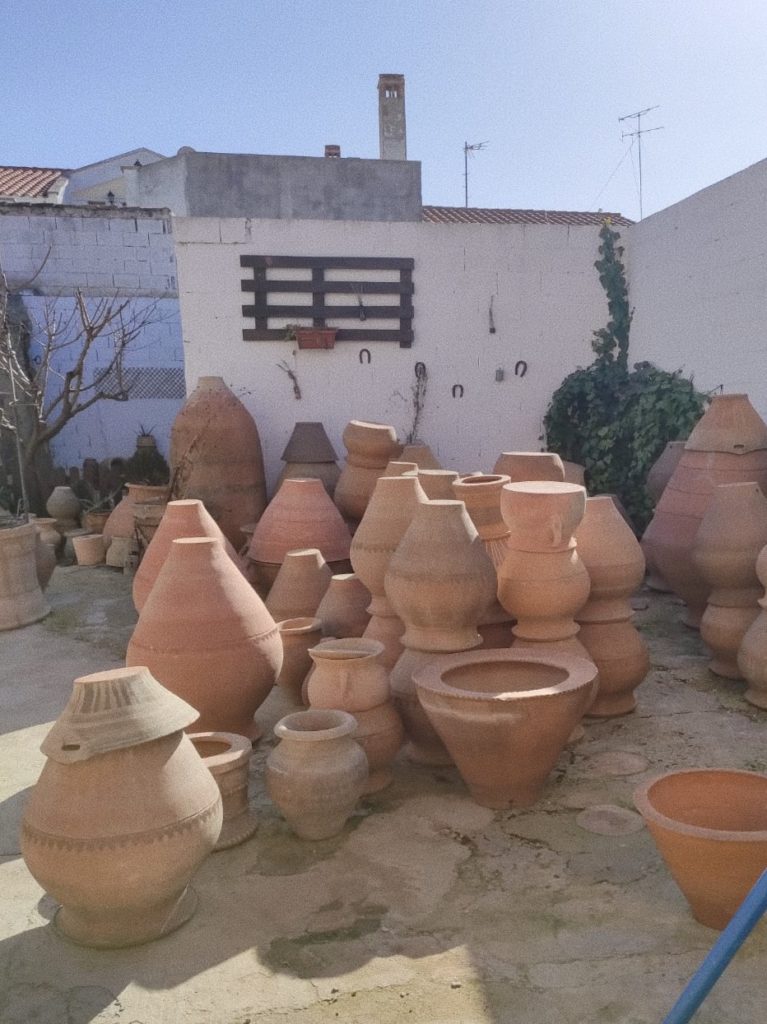NEW PROJECTS: THE AMPHORAS



It all started one day in December 2021 when I visited Lluis Romero to bring him some samples of JUEGO wines for his new project “The Catalan wine list”, a sort of “40 Principales” but with wines.
We chatted for a long time and tasted different “natural” wines, most of them made in ceramics (amphorae). I had already tasted some of these wines before and I thought they smelled. But this time, in spite of the evolving aromas typical of Jerez wines, I feel a spectacular potentiation of the flower and fruit of the variety. For the first time I feel the curiosity to try to make a wine inside the amphorae.
I call my friend Pepe Mendoza, with whom I have a special relationship and who I know has already experimented with these containers. We talk and he recommends me a manufacturer, but he is already retired. He also tells me about a very good guy from the Penedès, but he doesn’t know him personally and has never been to see him.
At the same time, in these same days, I contact Marta Arenas, former winemaker of Can Sais de Vall Llobrega, with whom we agree on the similarity of what has happened to us in the last eleven years. It has been almost a couple of years since we last met and I am looking forward to chatting and exchanging opinions with her. We meet for lunch, I ask her about her friend from Quart who makes amphorae, Eloi. She also tells me about a man from the Penedès called Carles Llarch (the same man I had been told about).
I look for information on the net about Carles Llarch, he makes a very good comb. I ask him to order a container and he tells me that first I have to get to know him and see what he does and then decide which one I want. He makes me think that when I order barrels I don’t ask for types of wood and what kind of toasting I want… he is right.
With the other one that he makes in Quart it is difficult for me to contact him and when I do he doesn’t give me prices because he is waiting for the first of the year, but he already tells me that he works with only one type of clay and that he has a lot of work to do.
I call Pablo Calatayud (Bodega del Roure, Valencia) to see how he sees it.
He immediately tells me that a wine from amphorae, and if it is white I have to think of a variety that can be enhanced by the clay, xarel-lo, garnatxa, macabeo…
THE VISIT TO CARLES LLARCH
I arrive at Font Rubí, a tiny village in the Alt Penedès, incredible views, the whole Penedès in front of me and the sea of Vilanova i la Geltrú in the background. He lives on the outskirts.
I meet Carles, we talk about landscape, vineyards, farmers, economy.
He shows me what he makes, I see the material and he offers me the possibility of tasting the same wine with two types of clay he works with.
A Macabeo that with white clay; I find that it enhances the variety and the smells of apple as I had never before enflairado. Then I tasted the same wine in mixed earthenware. I was frankly impressed. I discover a limpidity and transparency of the wine, an honesty, frankness and varietal nobility, together with this subtle character of mud dust and a persistent and balanced oxidation that gives it a distinctive and exciting character that the other wines do not have.
The reflection of the return trip is that there is another world of wine, which is not the traditional one, that they do not play the same league, that they are not comparable, but they are very worthy and have, in my opinion, room for improvement. I am already thinking about how I will make them…
I’m waiting a few days after receiving the quote from Carles. I keep going round and round. I go back to the net, I discover the origin of the amphorae in Georgia, manufacturers in Italy. I remember the trip we made with sommeliers and producers from Empordà in February 2018. We visited Azienda agrícola Cuerpo, among others. Now I see that it was a premonition, a preview of what was to come.
Finally, I write to Carles and order two amphorae and send him the deposit.
I have to think about what to put inside; Sauvignon Blanc, Grenache? If I can mature it with micro-oxygenation and enhance its varietal values, we could be talking about a time bomb, let’s see.
I’m thinking of re-grafting all the black grapes used to make Arriba, which I would stop making, and it would all be the new variety. Or maybe a part of it and keep some of the black grapes to make some bottles in the year of ARRIBA, we’ll see.
Project in progress.
I HAVE NOT HAD ENOUGH
On the 27th of January I will go to Villarrobledo, that is to say, because it is far away. There is a certain Maribel Orozco there who makes amphorae. I make a complete visit, everything very well explained, coherent message and finally I order 4 more amphorae of 500 litres approx.
Taking advantage of the trip I go to see Pablo Caltayud of the winery Madurez (Valencia) and Pepe Mendoza with whom we owe a visit a long time ago.
We discussed many topics, both general and particular.
But when it comes to making a white wine in amphorae, they both agree that I can’t make a sauvignon blanc and that I have to go for a garnacha blanca or a macabeo.
Through Pepe’s advice, he finds me some wood to graft in Terra Alta, in the winery Vinos del Trozo de Josep Arrufat…
TO LOOK FOR WOOD TO BE RE-GRAFTED
In Josep’s vineyard it’s a nice day and windy, surrounded by windmills, I find them pruning. We already knew each other, from 12 years ago. I had visited them and tasted their wines and visited their cellar.
They had cut the vine shoots and they were cutting them to the ground 10 by 10. I choose them, I clean them and then I send them out in a bin of 100 until I have about 2,400 shoots to re-fill 800 vines. Garnatxa blanca. The tòries make very good comb and the vineyard has an unbeatable aspect.
As we finish soon and they have little left to finish pruning the vineyard I start to cut with them.
Encabat let’s go to the cellar and the shop. Surprise! They have a lot of amphorae, this blow of tinajas Moreno (Torrrejoncillo, Cáceres). They have very good comb and the wines I taste made there inside their riquísimos.
On my way back home I try Cacerías and find out about prices and availability. By chance they have 700 litres in stock and the price is affordable. I order one for the next vintage.
So, we will have an amphora from Carles LLarch, one from Tinajas Moreno and 4 more from Orozco.
I will be able to try them and find out which ones I like best. This will give a wine with more variety (we sommeliers say complexity) and choose the ones I want for the future.
APPROACHES
I think about the potential of the wines I have tasted these days in Alicante, in the area, the touristic potential it has and the possibilities of selling a very good part of the production in the same winery and how easy it can be to show first hand the autochthonous varieties and the new way of interpreting them.
I have 6 bottles of Giro de en Casa Agrícola which are a godsend.
I am thinking of going a little deeper into the Levante region on the subject of wines and see if I can give a class in the sommelier course of these DOs (Requena, Alicante and Valencia) and try to communicate the transformation and change that they have undergone in the last 20 years thanks to people as persistent and with a vision of the future as these three musketeers: Toni Sarrion (Bodegas Mustiguillo, Valencia), Pepe Mendoza (Casa Agricola, Alicante) and Pablo Calatayud (Bodega Madurez, Valencia) among others.
On the 15th of February they give me the unofficial ok that I will have the new class in the sommelier course of the DOs of Levante, but in the same package are the wines of Aragón (Somontano, Cariñena, Campo de Borja and Calatayud) and the wines of the Community of Madrid.
I accept the challenge.

